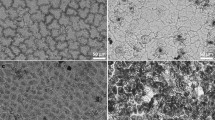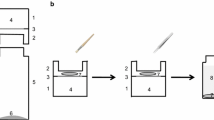Abstract
Cuticular penetration of five different 14C-labeled chemicals (benzoic acid, bitertanole, carbaryl, epoxiconazole and 4-nitrophenol) into Arabidopsis thaliana leaves was measured and permeances P (ms−1) were calculated. Thus, cuticular barrier properties of A. thaliana leaves have been characterized quantitatively. Epoxiconazole permeance of A. thaliana was 2.79 × 10−8 ms−1. When compared with cuticular permeances measured with intact stomatous and astomatous leaf sides of Prunus laurocerasus, frequently used in the past as a model species studying cuticular permeability, A. thaliana has a 48- to 66-fold higher permeance. When compared with epoxiconazole permeability of isolated cuticles of different species (Citrus aurantium, Hedera helix and P. laurocerasus) A. thaliana permeability is between 17- to 199-fold higher. Co-permeability experiments, simultaneously measuring 14C-epoxiconazole and 3H2O permeability of isolated cuticles of three species (C. aurantium, H. helix and P. laurocerasus) showed that 3H2O permeability was highly correlated with epoxiconazole permeability. The regression equation of this correlation can be used predicting cuticular transpiration of intact stomatous leaves of A. thaliana, where a direct measurement of cuticular permeation using 3H2O is impossible. Water permeance estimated for A. thaliana was 4.55 × 10−8 ms−1, which is between 12- and 91-fold higher than water permeances measured with isolated cuticles of C. aurantium, H. helix and P. laurocerasus. This indicates that cuticular water permeability of the intact stomatous leaves of the annual species A. thaliana is fairly high and in the upper range compared with most P values of perennial species published in the past.






Similar content being viewed by others
Abbreviations
- P :
-
Permeance
- C :
-
Compartment
- CM:
-
Isolated cuticle
- D :
-
Diffusion coefficient
- K cw :
-
Cuticle/water partition coefficient
References
Abraham MH, McGowan JC (1987) The use of characteristic volumes to measure cavity terms in reversed phase liquid chromatography. Chromatographia 23:243–246
Aharoni A, Dixit S, Jetter R, Thoenes E, van Arkel G, Pereira A (2004) The SHINE clade of AP2 domain transcription factors activates wax biosynthesis, alters cuticle properties, and confers drought tolerance when overexpressed in Arabidopsis. Plant Cell 16:2463–2480
Baur P (1997) Lognormal distribution of water permeability and organic solute mobility in plant cuticles. Plant Cell Environ 20:167–177
Baur P, Buchholz A, Schönherr J (1997) Diffusion in plant cuticles as affected by temperature and size of organic solutes: similarity and diversity among species. Plant Cell Environ 20:982–994
Bessire M, Chassot C, Jacquat AC, Humphry M, Borel S, Petetot JMC, Metraux JP, Nawrath C (2007) A permeable cuticle in Arabidopsis leads to a strong resistance to Botrytis cinerea. EMBO J 26:2158–2168
Branen JK, Shintani DK, Engeseth NJ (2003) Expression of antisense acyl carrier protein-4 reduces lipid content in Arabidopsis leaf tissue. Plant Physiol 132:748–756
Broun P, Poindexter P, Osborne E, Jiang CZ, Riechmann JL (2004) WIN1, a transcriptional activator of epidermal wax accumulation in Arabidopsis. Proc Natl Acad Sci USA 101:4706–4711
Buchholz A (2006) Characterization of the diffusion of non-electrolytes across plant cuticles: properties of the lipophilic pathway. J Exp Bot 57:2501–2513
Burghardt M, Friedmann A, Schreiber L, Riederer M (2006) Modelling the effects of alcohol ethoxylates on diffusion of pesticides in the cuticular wax of Chenopodium album leaves. Pest Manage Sci 62:137–147
Chen XB, Goodwin SM, Boroff VL, Liu XL, Jenks MA (2003) Cloning and characterization of the WAX2 gene of Arabidopsis involved in cuticle membrane and wax production. Plant Cell 15:1170–1185
Cussler EL (1984) Diffusion: mass transfer in fluid systems. University Press, Cambridge
Franke R, Briesen I, Wojciechowski T, Faust A, Yephremov A, Nawrath C, Schreiber L (2005) Apoplastic polyesters in Arabidopsis surface tissues: a typical suberin and a particular cutin. Phytochemistry 66:2643–2658
Geyer U, Schönherr J (1990) The effect of environment on permeability and composition of Citrus leaf cuticles: 1. Water permeability of isolated cuticular membranes. Planta 180:147–153
Hosy E, Vavasseur A, Mouline K, Dreyer I, Gaymard F, Poree F, Boucherez J, Lebaudy A, Bouchez D, Very AA, Simonneau T, Thibaud JB, Sentenac H (2003) The Arabidopsis outward K+ channel GORK is involved in regulation of stomatal movements and plant transpiration. Proc Natl Acad Sci USA 100:5549–5554
Jenks MA, Rashotte AM, Tuttle HA, Feldmann KA (1996) Mutants in Arabidopsis thaliana altered in epicuticular wax and leaf morphology. Plant Physiol 110:377–385
Kannangara R, Branigan C, Liu Y, Penfield T, Rao V, Mouille G, Hofte H, Pauly M, Riechmann JL, Broun P (2007) The transcription factor WIN1/SHN1 regulates cutin biosynthesis in Arabidopsis thaliana. Plant Cell 19:1278–1294
Kerler F, Schönherr J (1988) Permeation of lipophilic chemicals across plant cuticles: prediction from partition coefficients and molar volumes. Arch Environ Contam Toxicol 17:7–12
Kerstiens G (2006) Water transport in plant cuticles: an update. J Exp Bot 57:2493–2499
Kerstiens G, Schreiber L, Lendzian KJ (2006) Quantification of cuticular permeability in genetically modified plants. J Exp Bot 57:2547–2552
Kirsch T, Kaffarnik F, Riederer M, Schreiber L (1997) Cuticular permeability of the three tree species Prunus laurocerasus L., Ginkgo biloba L. and Juglans regia L.: comparative investigation of the transport properties of intact leaves, isolated cuticles and reconstituted cuticular waxes. J Exp Bot 48:1035–1045
Kolattukudy PE (2001) Polyesters in higher plants. Adv Biochem Eng Biotech 71:1–49
Kurdyukov S, Faust A, Nawrath C, Bär S, Voisin D, Efremova N, Franke R, Schreiber L, Saedler H, Metraux JP, Yephremov A (2006) The epidermis-specific extracellular BODYGUARD controls cuticle development and morphogenesis in Arabidopsis. Plant Cell 18:321–339
Li YH, Beisson F, Koo AJK, Molina I, Pollard M, Ohlrogge J (2007) Identification of acyltransferases required for cutin biosynthesis and production of cutin with suberin-like monomers. Proc Natl Acad Sci USA 104:18339–18344
Li-Beisson Y, Pollard M, Sauveplane V, Pinot F, Ohlrogge J, Beisson F (2009) Nanoridges that characterize the surface morphology of flowers require the synthesis of cutin polyester. Proc Natl Acad Sci USA 106:22008–22013
Lolle SJ, Berlyn GP, Engstrom EM, Krolikowski KA, Reiter WD, Pruitt RE (1997) Developmental regulation of cell interactions in the Arabidopsis fiddlehead-1 mutant: a role for the epidermal cell wall and cuticle. Dev Biol 189:311–321
Mang HG, Laluk KA, Parsons EP, Kosma DK, Cooper BR, Park HC, AbuQamar S, Boccongelli C, Miyazaki S, Consiglio F, Chilosi G, Bohnert HJ, Bressan RA, Mengiste T, Jenks MA (2009) The Arabidopsis RESURRECTION1 gene regulates a novel antagonistic interaction in plant defense to biotrophs and necrotrophs. Plant Physiol 151:290–305
Millar AA, Clemens S, Zachgo S, Giblin EM, Taylor DC, Kunst L (1999) CUT1, an Arabidopsis gene required for cuticular wax biosynthesis and pollen fertility encodes a very-long-chain fatty acid condensing enzyme. Plant Cell 11:825–838
Molisch H (1912) Das Offen- und Geschlossensein der Spaltöffnungen veranschaulicht durch eine neue Methode. Zeitsch f Bot 4:106–122
Nawrath C (2006) Unraveling the complex network of cuticular structure and function. Curr Opin Plant Biol 9:281–287
Niederl S, Kirsch T, Riederer M, Schreiber L (1998) Co-permeability of 3H-labeled water and 14C-labeled organic acids across isolated plant cuticles: investigating cuticular paths of diffusion and predicting cuticular transpiration. Plant Physiol 116:17–123
Nobel PS (2009) Physicochemical and environmental plant physiology. Academic Press, San Diego
Panikashvili D, Savaldi-Goldstein S, Mandel T, Yifhar T, Franke RB, Hofer R, Schreiber L, Chory J, Aharoni A (2007) The Arabidopsis DESPERADO/AtWBC11 transporter is required for cutin and wax secretion. Plant Physiol 145:345–1360
Panikashvili D, Shi JX, Schreiber L, Aharoni A (2009) The Arabidopsis DCR encoding a soluble BAHD acyltransferase is required for cutin polyester formation and seed hydration properties. Plant Physiol 151:773–1789
Pollard M, Beisson F, Li YH, Ohlrogge JB (2008) Building lipid barriers: biosynthesis of cutin and suberin. Trends Plant Sci 13:36–246
Riederer M, Schreiber L (2001) Protecting against water loss: analysis of the barrier properties of plant cuticles. J Exp Bot 52:2023–2032
Samuels L, Kunst L, Jetter R (2008) Sealing plant surfaces: cuticular wax formation by epidermal cells. Annu Rev Plant Biol 59:683–707
Schnurr J, Shockey J, Browse J (2004) The acyl-CoA synthetase encoded by LACS2 is essential for normal cuticle development in Arabidopsis. Plant Cell 16:629–642
Schönherr J (2006) Characterization of aqueous pores in plant cuticles and permeation of ionic solutes. J Exp Bot 57:2471–2491
Schönherr J, Bukovac MJ (1972) Penetration of stomata by liquids. Plant Physiol 49:813–819
Schönherr J, Riederer M (1986) Plant cuticles sorb lipophilic compounds during enzymatic isolation. Plant Cell Environ 9:459–466
Schönherr J, Riederer M (1989) Foliar penetration and accumulation of organic chemicals in plant cuticles. Rev Environ Contam Toxicol 108:1–70
Schreiber L (2006) Review of sorption and diffusion of lipophilic molecules in cuticular waxes and the effects of accelerators on solute mobilities. J Exp Bot 57:2515–2523
Schreiber L (2010) Transport barriers made of cutin, suberin and associated waxes. Trends Plant Sci 15:546–553
Schreiber L, Riederer M (1996) Ecophysiology of cuticular transpiration: comparative investigation of cuticular water permeability of plant species from different habitats. Oecologia 107:426–432
Schreiber L, Schönherr J (1992a) Analysis of foliar uptake of pesticides in barley leaves: role of epicuticular waxes and compartmentation. Pestic Sci 36:213–221
Schreiber L, Schönherr J (1992b) Uptake of organic chemicals in conifer needles: surface adsorption and permeability of cuticles. Environ Sci Technol 26:153–159
Schreiber L, Schönherr J (1993a) Determination of foliar uptake of chemicals: influence of leaf surface microflora. Plant Cell Environ 16:743–748
Schreiber L, Schönherr J (1993b) Uptake of two chlorinated chemicals in conifer needles: reversibility and compartmental analysis. New Phytol 123:547–554
Schreiber L, Schönherr J (2009) Water and solute permeability of plant cuticles. Measurement and data analysis. Springer, Heidelberg
Sieber P, Schorderet M, Ryser U, Buchala A, Kolattukudy P, Metraux JP, Nawrath C (2000) Transgenic Arabidopsis plants expressing a fungal cutinase show alterations in the structure and properties of the cuticle and postgenital organ fusions. Plant Cell 12:721–738
Strand A, Hurry V, Henkes S, Huner N, Gustafsson P, Gardeström P, Stitt M (1999) Acclimation of Arabidopsis leaves developing at low temperatures: increasing cytoplasmic volume accompanies increased activities of enzymes in the Calvin cycle and in the sucrose-biosynthesis pathway. Plant Physiol 119:1387–1398
Tanaka T, Tanaka H, Machida C, Watanabe M, Machida Y (2004) A new method for rapid visualization of defects in leaf cuticle reveals five intrinsic patterns of surface defects in Arabidopsis. Plant J 37:139–146
Xiao FM, Goodwin SM, Xiao YM, Sun ZY, Baker D, Tang XY, Jenks MA, Zhou JM (2004) Arabidopsis CYP86A2 represses Pseudomonas syringae type III genes and is required for cuticle development. EMBO J 23:2903–2913
Yephremov A, Wisman E, Huijser P, Huijser C, Wellesen K, Saedler H (1999) Characterization of the FIDDLEHEAD gene of Arabidopsis reveals a link between adhesion response and cell differentiation in the epidermis. Plant Cell 11:2187–2201
Acknowledgments
Supply of radiochemicals by agrochemical companies is acknowledged. The authors are indebted to Dr. Jörg Schönherr for critically reading an earlier version of this manuscript. This work was supported by grants provided by the DFG (Deutsche Forschungsgemeinschaft; SCHR 506/9-1) and the BASF to LS.
Author information
Authors and Affiliations
Corresponding author
Rights and permissions
About this article
Cite this article
Ballmann, C., De Oliveira, S., Gutenberger, A. et al. A radioactive assay allowing the quantitative measurement of cuticular permeability of intact Arabidopsis thaliana leaves. Planta 234, 9–20 (2011). https://doi.org/10.1007/s00425-011-1381-4
Received:
Accepted:
Published:
Issue Date:
DOI: https://doi.org/10.1007/s00425-011-1381-4




